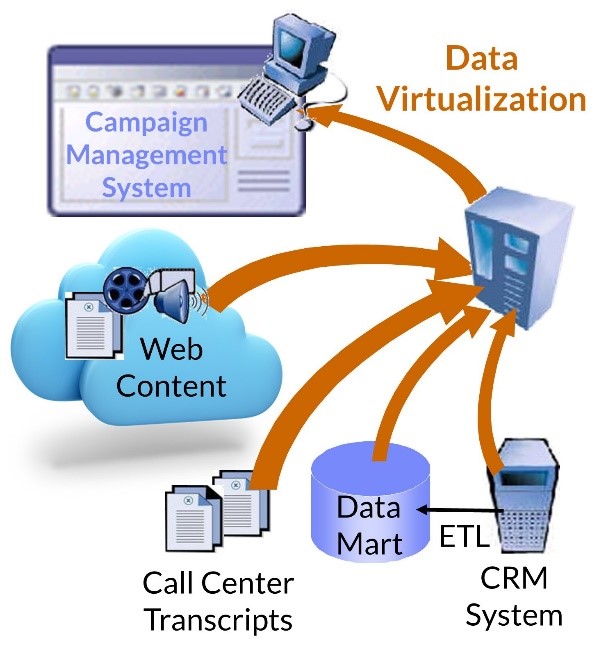
Alice Well’s early successes as CIO at Advanced Banking Corporation (ABC) in solving the old problem of getting real-time data (Gaining
It’s also fair to say that another key contributor to her success is her understanding of the organizational implications of major changes in the IT infrastructure. Now, with the pressure building at board level for significant and visible advances in delivery of digital transformation, all of Alice’s organizational skills and technological nous will be needed.
Never one to shirk a challenge, Alice has determined that a central precept for a digital business would be to provide a single, fully integrated, contextually sensitive interface to all ABC’s multitudinous data sources for all the business. As she commits her new annual objectives to CEO, Bill Costly, she reflexively turns to her by now well-known mantra: “all is well, all will be well.”
As with every large business, ABC’s slate of data sources has grown exponentially over recent years. Not only has the variety of sources of numerical, well-structured data—SQL, NoSQL, and spreadsheets—grown rapidly. In addition, the business has developed a huge appetite for all types of more loosely structured data—everything from text files and e-mails in content management systems to web pages and sources, such as LinkedIn and Facebook.
Across the organization, the clamor is nearly deafening as every function competes for access to their favorite unique and usually urgently needed source. With the demand for an enterprise-wide data virtualization infrastructure growing, Alice takes a stand. She well knows that infrastructure projects claiming to “immediately benefit everybody” seldom deliver on their promise. What is needed is a focused project with well-bounded goals that delivers early value to one part of the business and can be rolled out widely afterwards. When CMO, Mark Ed Price, comes looking to invest in a new campaign management solution, Alice knows that she has found her perfect project to prove the value of data virtualization across the widest variety of sources.
Curing Campaign Management Misery
ABC has had an on-premises Customer Relationship Management system supported by a reporting data mart for some years now. The CMO would like to have better Campaign Management, with access to customer conversations from the ABC call center, as well as sentiment from Facebook and Twitter feeds. Buying a new, integrated Campaign Management System (CMS) has been costed as far too expensive, especially when all the data consolidation and transfer work from existing systems is included. What is an embattled CMO to do?
Data virtualization to the rescue! As shown below, ABC’s existing Denodo Data Virtualization Platform allows data from all the required platforms to be accessed and consolidated into a bespoke CMS application.

One of the long-standing strengths of Denodo Data Virtualization has been the wide range of different types of sources and systems from which it can obtain data.
Traditionally, data virtualization products focus on well-structured data sources. Relational databases (RDBs) are the most obvious example, and Denodo supports a comprehensive set of traditional RDBs, as well as cloud-based systems (such as Amazon Redshift and Snowflake), appliances (e.g. HP Vertica and IBM Netezza), and open sources systems (like PostgreSQL and Amazon Derby). With support for NoSQL stores, hierarchical databases (such as IMS and Adabas), CSV (comma separated variable) files and spreadsheets, Denodo clearly covers all the bases for well-structured data.
Turning to text sources, Denodo supports standard file formats, such as pdf, Word documents, text, and e-mails from file systems and content management systems. Content can also be accessed from search systems, web pages, web apps (such as Amazon, Facebook, LinkedIn, Twitter, etc), and even semantic repositories. And there’s more sources to be found in the Denodo documentation.
Build vs. Buy
Alice’s solution for Campaign Management builds on the power of data virtualization to access data from all the existing data sources in ABC. However, it clearly also involves the building of a new application, with all its attendant costs. Why not just buy an off-the-shelf CMS?
When building a new business, or when a business has been built around a single (often cloud-based) system such as Salesforce, an off-the-shelf CMS is often a good choice. However, in a case like ABC, with a plethora of existing systems that would need to feed the new CMS or be replaced by it, data virtualization can be a very cost-effective approach.
A further advantage is that data virtualization offers an agile development approach, allowing data sources to be added in stages and tested in realistic scenarios. With the Denodo’s Dynamic Data Catalog, business people can locate additional data sources not previously included in the CMS scope, and with Dynamic Query Optimization, can be assured of well-performing access.
And They All Lived Happily Ever After…
With this, we reach the end of Alice’s story. With Denodo Data Virtualization Platform, she has gifted ABC with an agile, performant infrastructure for direct access to data on a wide variety of platforms. The infrastructure can be used to support general business intelligence use for real-time data and external data sources, as well as enabling specific applications. These systems can be built in stages and modified with ease in an agile development environment. Business people can find what they need and discover data they might never have known would be useful to them.
As Alice Well is well known for saying: all is well, and all will be well* with data virtualization.
* Alice’s mantra is based on the passage “All shall be well, and all shall be well, and all manner of thing shall be well” from “Revelations of Divine Love” by 14th century anchorite, Julian of Norwich. This is first book in the English language known to have been written by a woman.
- The Data Warehouse is Dead, Long Live the Data Warehouse, Part II - November 24, 2022
- The Data Warehouse is Dead, Long Live the Data Warehouse, Part I - October 18, 2022
- Weaving Architectural Patterns III – Data Mesh - December 16, 2021
